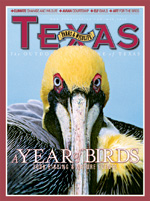
From the Pen of Carter P. Smith
I am the son of a birder. Actually, make that two birders, although one is arguably more serious than the other.
My father, a rather cerebral type, has an insatiable curiosity about the whys, whats and hows of the natural world. Among other things, he keeps meticulous records of his bird observations at the ranch and expects the same of others. Heaven help any of our lease hunters or other guests who inadvertently neglect to mention to him an encounter with a Montezuma quail, a zone-tailed hawk or even a common shoveler down by the river. Suffice to say, his data sets are impressive even by the most rigorous of scientific standards.
My sweet mother, on the other hand, seems to appreciate more of the social and aesthetic attributes of birding. She derives enormous pleasure at the first sighting of a male vermilion flycatcher and the return of the black-chinned hummingbirds that dart from feeder to feeder under the live oaks in front of the porch. Ensuring that the scores of naturalists and scientists who visit the ranch in the spring to study the birds are well-fed and well-stimulated with ample evening conversation is her hallmark. Together, my parents make a great pair, and their mutual enjoyment of birding only reaffirms that.
Well, it's springtime in Texas, and our state's estimated 3.8 million wildlife watchers, including my parents, are out and about, scouring the countryside for resident and migratory birds alike. It's no wonder why. Texas leads the nation, with more than 600 species of birds. The choice of birding spots is nearly unparalleled in all of North America. Who wouldn't want to catch a glimpse of a green jay or kiskadee in the deep South Texas brush country, a soaring black hawk along Limpia Creek in the Davis Mountains, a reddish egret foraging in the Laguna Madre, or a summer tanager flitting through the brush of a Hill Country pasture?
The economic impacts of wildlife watchers are felt throughout the state, particularly in rural areas. According to the U.S. Fish and Wildlife Service 2006 National Survey of Fishing, Hunting and Wildlife-Associated Recreation, wildlife watchers contribute more than $5 billion to the Texas economy. That comes from expenditures related to travel, lodging, sporting goods and even recreational land to support their nature-based pursuits. It is no wonder that communities from Weslaco to Canadian have embraced these nature tourists, particularly birders, as part of their long-term economic development plans.
What makes all of this possible, of course, is the uniqueness and diversity of habitats found in Texas. With 11 different ecoregions ranging from the grasslands of the high plains to the barrier islands of the coast, Texas is very biologically diverse. Our charge at the department is to ensure that it stays that way for future Texans, both the avian and people kind.
So, whether you are a birder or not, I hope you'll get outside this month and enjoy the best that Texas has to offer in the outdoors. I hope in doing so that you'll consider visiting one of the 90 state parks or 51 wildlife management areas across Texas.
As we like to say, Life's Better Outside. Don't forget to bring your binoculars!

